Of Emus and Fairy-wrens
Photographing Australia’s Endemic Birds
Monthly Newsletter
January 2007
At least this newsletter isn’t an entire month late and I should be all caught up and have everything updated now. Sorry if I have been a bit lax on my updating but I must say, I would rather be photographing than sitting in front of a computer any day.
Anyway, January seemed to be quite different than the previous five months. First of all, it marked my halfway point through this year which is hard to believe. In many ways I feel like I have just arrived, yet in others I feel like I have been here forever. It is one of those paradoxes that I think always occurs when you are away from what you have always known. I also found myself photographing more landscapes this month than I have so far this year and that is quite obvious from the selection of photos below. That being said, I did get to photograph some great birds as well.
The New Year dawned with my girlfriend and I still in Tasmania, but in a few days we returned to the mainland to do a bit of sightseeing in Victoria. Prior to her departure on the 10th, we saw Great Ocean Road, the Grampians, and the Little Desert. As I mentioned in December’s newsletter, I had taken a break from my daily photographic pursuits during this period so I don’t have much to show for this time. It really was nice to have a bit of a break and even better to have a traveling companion even if it was only for three weeks.
When I was back on my own, it took me a while to get back into the swing of things and it was several days before I had captured some photographs I was pleased with. I started out by exploring some of the parks in the eastern suburbs of Melbourne. I spent time in the Yarra Ranges, Binyip State Park, and other smaller parks in the region. During my visits to these parks I was rather unsuccessful as far as photography was concerned, but finally after several days at Starling Gap in the Yarra Ranges, I managed to photograph a Pilotbird. These small skulking birds of the undergrowth were one of my target birds as I will soon be leaving their range and I hadn’t seen them yet. I finally found a pair of them and while it took a couple days, I managed to get some photos I was quite pleased with.
My plan for the month consisted of a large counterclockwise circle with Melbourne in the center. After leaving the eastern suburbs, I headed north to Terrick Terrick National Park. If you follow my weblogs, you may remember that I visited the park in December on a bit of a whim with the slight chance of seeing a Plains-wanderer. While I was totally unsuccessful then, I decided that I would try and get some local expertise to see if I could see these curious little birds. Fortunately, Chris Coleborn, a local who is quite active with the Terricks, offered to set up a spotlighting trip for these birds so off I went to meet him in the middle of the month.
The trip turned out to be one of those memorable nights when everything seemed to go right. We saw no less than five Plains-wanderers and I was able to photograph both males and females. We also saw a male Little Buttonquail with three tiny little chicks that could only have been a few days old. While I don’t know a lot about reptiles, the group was quite excited about finding two Hooded Scalyfoots, a highly endangered legless lizard, as well as a handful of Curl Snakes. To top things off in the mammal department, we had a nice Fat-tailed Dunnart make an appearance.
I left the Terricks after several productive days where I was able to photograph other birds like a pair of Gilbert’s Whistlers and a party of White-browed Babblers as well. From the Terricks, I headed to the Grampians where I had hoped to photograph some of the regrowth of the forest after the massive bushfires of January 2006. Unfortunately, the weather and my motivation combined to produce several very unproductive days and I left without much to show for my time there.
The rest of the month I spent along Great Ocean Road photographing both the spectacular coastline and the waterfalls of the interior. It turned out to be quite productive despite weather that didn’t want to cooperate as I had hoped. The coastline here is spectacular with sandstone formations that are beyond comparison. The Great Otway National Park which preserves most of the hinterland is dotted with spectacular waterfalls in the midst of lush rainforests. It is justifiably, one of the most visited tourist regions in Australia.
I tried to divide my time between the rainforest waterfalls and the coastline and I think I came away with a decent set of images. I have included a few here as well as posted a lot more in the galleries so be sure to check them out.
My last adventure in January was a trip to the Western Treatment Plant in Werribee. This water treatment plant is renowned for the birdlife that flocks to the wetlands where water is discharged. The plant is only open to locals who have a permit and I was fortunate to spend the day with Dave Torr who volunteered to show me around. The size of the plant was hard to believe and birding it reminded me a lot of birding one of my favorite locations back home, Merritt Island National Wildlife Refuge on the east coast of Florida. We saw a ton of birds and I added a few more to my list which is always nice.
After leaving the plant, I spent a day getting things organized and a little bit of repair work done and on the evening of February 1, 2007, I boarded the boat to return to Tasmania. I will be spending the month of February in Tassie before returning to the mainland for a bit of vacation and traveling with my parents. Because of that, my February newsletter probably will not be posted until later in March as I will be on the road. In the meantime, I hope everyone has a great month.
Website Announcements
Once again, I have updated everything on the site. The weblogs should be updated through the present as well as a full update of the galleries. Enjoy the new photos.
The Photos
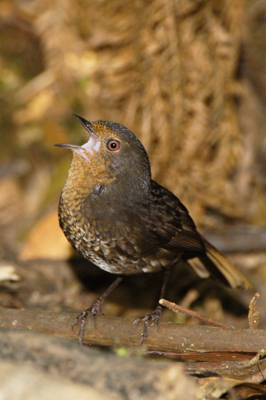
Pilotbird – Starling Gap, Yarra Ranges, Victoria
These small brown birds tend to skulk in the dense undergrowth of fern gullies making them quite hard to photograph. I spent two mornings with a pair of birds and only managed to get photos I was pleased with during the last half hour or so of my second morning. As these birds are found pretty much on the southeast coast, I was determined to see them before I left their range.
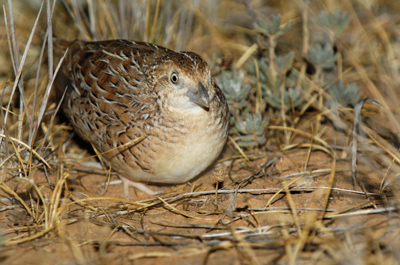
Little Buttonquail – Terrick Terrick National Park, Victoria
The buttonquail are an interesting family of birds that are very difficult to see. I had all but written off most of the birds in the family as difficult to see, much less to photograph. Because of this, I was quite pleased to get a chance to photograph the male Little Buttonquail on the night of my search for the Plains-wanderers.
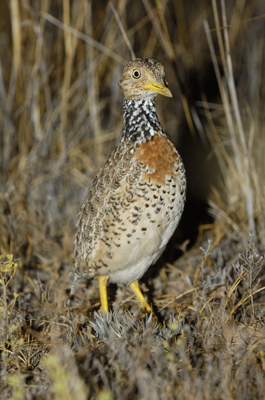
Plains-wanderer – Terrick Terrick National Park, Victoria
The Plains-wanderer is a bit of an enigma to ornithologists concerning their taxonomy. They were first classified as closely related to the buttonquail but now have been reclassified through genetic testing as more closely related to waders and placed in an entirely different order and in their own family. They also have a bit of a different mating system, opposite that of most birds. The male incubates and raises the chicks while the females are promiscuous. As a result of this, the female is the more colorful of the sexes with the male lacking the chestnut breast and less boldly patterned necklace. They are found only in a few remaining native grasslands and are quite difficult to see. Because of all this, I was quite pleased to not only see five during my outing but be able to photograph several of them.
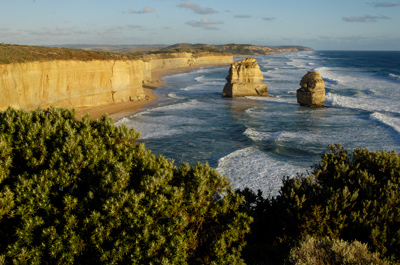
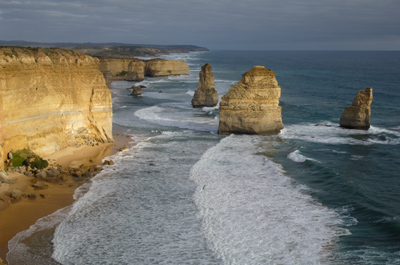
The Twelve Apostles – Great Ocean Road, Victoria
The 12 Apostles are probably the most iconic of Australian landscapes with the possible exceptions of either the Great Barrier Reef or Uluru. They are also one of the most photographed icons as well. Knowing this, I couldn’t leave without taking a photo or two for myself. I spent a couple evenings and mornings photographing them. The top image is taken from the official overlook and looking east just before sunset. The bottom image is taken from a headland, just to the west of the main overlook and is also facing east on a cloudy evening when the sun poked through for only a few brief moments.
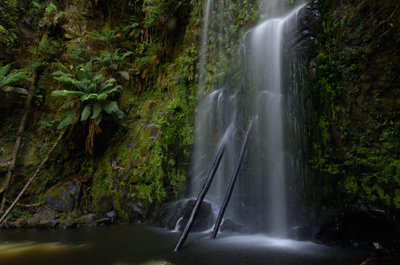
Beauchamp Falls – Great Otway National Park, Victoria
The waterfalls of Great Otway National Park are quite spectacular. Due to the recent drought, water flow is a bit low right now, but they still are quite photogenic. The top of this falls was in bright sunlight while the bottom was in deep shade making it impossible to photograph the entire falls. I found this composition to be quite pleasing and was very happy with the way it turned out.
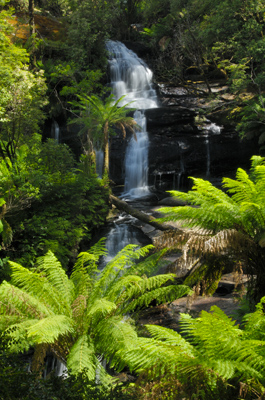
Triplet Falls – Great Otway National Park, Victoria
The giant ferns of the forest around these falls are hard to turn down. Again, the extreme contrast of harsh sunlight and deep shade was hard to cope with but this is one of the images I am most pleased with from my time in the area.
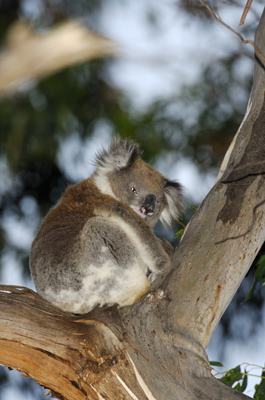
Koala – Great Otway National Park, Victoria
Of course, Great Ocean Road has more than just spectacular landscapes. It also has quite a healthy population of Koalas, in fact the only Koalas I have seen. They can be difficult to photograph as they seem to always be sleeping but I was pleased to find this one that looked up every time a car drove by.
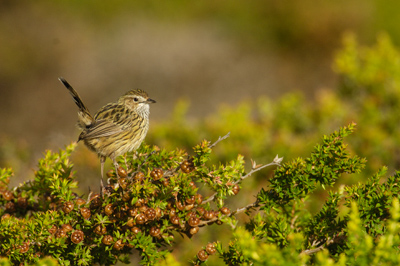
Striated Fieldwren – The Grotto, Great Ocean Road, Victoria
Beyond Koalas, Great Ocean Road has several bird species that I made a point of photographing. This Striated Fieldwren was singing along the walk out to The Grotto and turned out to be quite cooperative perching for me in wonderful early morning light.
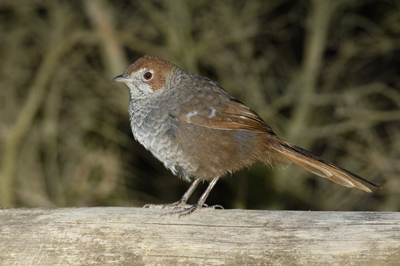
Rufous Bristlebird – Airey’s Inlet, Great Ocean Road, Victoria
The Rufous Bristlebird was definitely my target bird for the Great Ocean Road region. They are found in the coastal heathland along the Victorian coast and just a bit into South Australia but that is the limit of their range. Of the three bristlebird species, this is supposed to be the easiest to see. It turned out that it was easy to see but difficult to photograph since it was always hopping around a car park on pavement. Only after a couple mornings and several different locations did I find a bird that would feed in the vegetation at the edge.
Until next month be sure to check out the website as it has just been fully updated!
